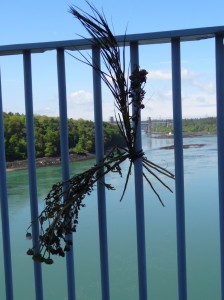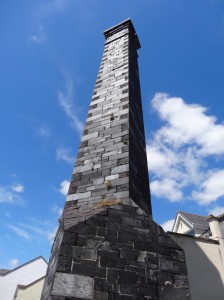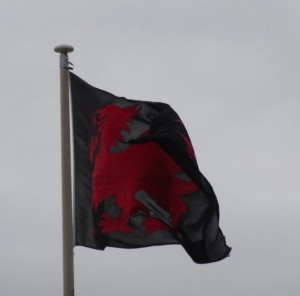The walking this day is easy, albeit not exciting, but after a day of interminable forest, trackless dunes, and penitential shingle, not exciting is good.
 Out of Menai Bridge you cross back across the suspension bridge that you crossed 130 miles earlier. Parway across a withered bunch of flowers is tied to the railings, a poignant marker; given its location I assume a memorial after a suicide rather than accidental drowning.
Out of Menai Bridge you cross back across the suspension bridge that you crossed 130 miles earlier. Parway across a withered bunch of flowers is tied to the railings, a poignant marker; given its location I assume a memorial after a suicide rather than accidental drowning.
The path drops down towards the waterside through the Botanical Gardens. I loved the labels in the gardens; instead of the normal metal or plastic labels, the specimen trees have a half log of wood in front with the names carved into the cut face.
At the Britannia Bridge the path comes up and turns inland to follow a cycle path beside the main Bangor–Caernarfon road. While the suspension bridge is Telford, this bridge is Robert Stevenson. The original ‘tubular’ bridge carried the London–Holyhead railway through two rectangular tunnels; a section of the tunnels is preserved partway up the track as you climb from below the bridge. It is well labelled, but would be easy to miss, as it lies in a rough area that looks like a lorry turning circle, but the lady with the black spaniel the day before had warned me to look out for it. The quality of Stevenson‘s engineering was such that the original supports could be adapted so that it now takes not only modern trains, but also a roadway above as a double-decker construction.
For a few miles the path stays close to the A road, passing an interesting Welsh café on one roundabout, but sadly a little soon after breakfast to stop. After a while it drops along an old railway line following the existing Lon Las Menai trail, on the whole clear to follow, but at one point branching with an upper and lower path. The upper well-metalled path is well signposted as a cycle route, but the lower, unsigned, more tree-sheltered one is the footpath route. However, both run close together with steps between halfway to recover if you take the wrong one and both will get you in to Y Felinheli at different points.
 The lower route comes out at the Felinheli marina, where a lovely swing bridge crosses the old docks. Coming to the promenade, small dinghies were meandering in the sunshine and a family of cygnets paddled in a puddle while their parents looked on. I had passed the Halfway House on the way down, which I assume was half way between Bangor and Caernarfon on the old turnpike, but did stop for lunch at the Garddfon, which, I was later told, used to be the haunt of "just a few heavy drinkers", but is now serving the more prosperous marina folk, but without feeling gentrified. I had the soup of the day, Thai chicken soup.
The lower route comes out at the Felinheli marina, where a lovely swing bridge crosses the old docks. Coming to the promenade, small dinghies were meandering in the sunshine and a family of cygnets paddled in a puddle while their parents looked on. I had passed the Halfway House on the way down, which I assume was half way between Bangor and Caernarfon on the old turnpike, but did stop for lunch at the Garddfon, which, I was later told, used to be the haunt of "just a few heavy drinkers", but is now serving the more prosperous marina folk, but without feeling gentrified. I had the soup of the day, Thai chicken soup.
After cutting round the small industrial area at the west end of Y Felinheli, the path follows along a well-made and wheelchair-friendly route along further old railway tracks to Caernarfon. At one point there is a large abandoned house up to the left and towards the shore what at first appears to be a line of small lived-in Victorian cottages until I realise that they too have gaps in their slates. Given their location I am amazed that they have not been snapped up by a developer, but perhaps access is difficult.
At around the same point is another abandoned dwelling, but this time a simple railway worker’s shelter, maybe for a pointsman, or simply where maintenance workers would shelter. A solid construction of vertical sleepers that will not decay easily, the smell of creosote still strong after a hundred years. I imagine a group of two or three Victorian workers huddled around the small fireplace while the rain falls outside.
The path enters Caernarfon past a new waterside apartment complex, Morrisons, the ‘Celtica‘ shopping complex, the Galeri arts centre and old docks, now a yacht-filled marina. On the dockside a series of ceramic mosaics celebrate the ‘New Europe‘, each contributed by a different local school, Cheska Rebublika, Cyprus (in Greek lettering), Polska, and more.
 At the end of the docks old anchors and ships’ metalwork are gathered outside a small shed-like building, which, I am told, was once the Maritime Museum. Now, from the side door I see the arm of a scarecrow; drawing closer, through the open door I see a giant Rubik’s cube. At first I take this to be something to do with children’s play, but then a man comes out to work on the scarecrow and he explains that he is a TV prop maker. His workshop includes a large green-screen area for photographing the props. The scarecrow, its siblings and what appears to be a plastic lamb, which are scattered around the workshop, are part of a popular farm game show.
At the end of the docks old anchors and ships’ metalwork are gathered outside a small shed-like building, which, I am told, was once the Maritime Museum. Now, from the side door I see the arm of a scarecrow; drawing closer, through the open door I see a giant Rubik’s cube. At first I take this to be something to do with children’s play, but then a man comes out to work on the scarecrow and he explains that he is a TV prop maker. His workshop includes a large green-screen area for photographing the props. The scarecrow, its siblings and what appears to be a plastic lamb, which are scattered around the workshop, are part of a popular farm game show.
Caernarfon is famous for the extensive Norman castle where Prince Charles was invested as Prince of Wales in 1969. The title is problematic. It is now given to the heir to the throne, a tradition starting when Edward the First, after a bloody campaign in Wales, said to the people gathered, "do you want a Prince of Wales", "yes" they answered, thinking of a prince in the line of Llewelyn the Great, but instead Edward said, "I give you a Prince of Wales", and held up his new baby son. So from being a title representing the independence of a nation, it became a symbol of oppression.
Maybe Prince William‘s time serving on Anglesey and warming the hearts of the people may make him a more acceptable when eventually Prince Charles becomes king, and he inherits the title, and maybe, he or his child, will be constitutional prince of a once more independent Wales.
Around the castle is a walled town, although the main shopping area is in the square (which is roughly triangular) in front of the castle gates.
I see the back of a solid building, now decaying slightly with foliage sprouting from its upper brickwork, and a for sale notice. It is the Conservative Club.
The area within the walls is still called ‘High Street‘, although nowadays many of the shops, like the decaying Conservative Club, are shut down. But ahead, on the corner, is a white-painted welcoming shop front, and through the door, in large letters I see:
‘Spatial Threads‘
Are they are talking about walking?
 It is a small gallery, and looks empty as I wander in, rich purple fabric ruffling across the wall. I approach the desk where leaflets are spread, intending to take one and depart, in true guerrilla tourist fashion. I start to reach and then, like a scene from The Wizard of Oz, a face pops up, jack-in-the-box-like. Yvonne is a graphic designer and one of the directors of Bocs, the gallery I was in. Yvonne is not tall and sitting behind the podium desk was completely invisible, as I guess I was, until she stood.
It is a small gallery, and looks empty as I wander in, rich purple fabric ruffling across the wall. I approach the desk where leaflets are spread, intending to take one and depart, in true guerrilla tourist fashion. I start to reach and then, like a scene from The Wizard of Oz, a face pops up, jack-in-the-box-like. Yvonne is a graphic designer and one of the directors of Bocs, the gallery I was in. Yvonne is not tall and sitting behind the podium desk was completely invisible, as I guess I was, until she stood.
The title ‘Spatial Threads‘ was a brief given to two artists, to use the space of the gallery. The manipulated fabrics of the first room are Alana Tyson‘s work, rich and organic.
Yvonne invites me to look around the second room of the gallery, where Bernadette Rippon has taken the theme in a different direction, where multiple white threads, inspired by wool-wisps on barbed wire, stretch almost invisibly across the room, stretched tight in semi-geometric curves and lines, the ends scattered carelessly like wind-blown wool on the ground. Slight shadows play across the window light, making fresh lines on the wall.
The idea of the walk as a thread has been a recurring image, but whereas the lines of path and road are clear and permanent, the lines of the walker are ephemeral and passing like the shadows that play and fade. For a while the foot-trodden grass or sandy footprint lies testament to the steps, yet is soon blown in the wind or washed with the tide, leaving only half-remembered shapes in the mind.
Solnit talks of the walk like thread connecting the land, and the manipulated fabric both reminds me of the rugged tectonic-plate crumpled and ice-scoured Snowdonian landscape that rises behind Caernarfon, but also of the way the threads of road and railway change the nature of distance in the land, just as the threads bring fabric closer. Once Anglesey was an island, now sewn to the land through Telford’s and Stevenson‘s bridges.
Later Paul says, "I can get to London in four and half hours and Manchester airport in two, but it takes me five and half hours to get to Cardiff, the same as Edinburgh". The fast North Wales expressway and the Holyhead to London line shrink distance, crumpling the UK map, yet limited eventually by the physical limitations of land, like fabric, although maybe also the political and economic limitations that say movement to England is more important than movement within Wales.
 The mountain-fragmented topography of Wales is the reason it took the English so long to defeat, and never fully subjugate, the land, but also, together with the naturally fractious character of the Celts, why it was so hard to unite the British against the Saxon and Norman invaders. The former is still evident today, no longer in terms of swords and horsemen, but in the permeation of English culture and language, where the mountain-backed fringes have been where Welsh language and culture were preserved. The latter, the fragmentation of the Welsh people, is still also sadly a problem, with the North Wales folk hardly, and often not, restraining their distrust of central administration in Cardiff.
The mountain-fragmented topography of Wales is the reason it took the English so long to defeat, and never fully subjugate, the land, but also, together with the naturally fractious character of the Celts, why it was so hard to unite the British against the Saxon and Norman invaders. The former is still evident today, no longer in terms of swords and horsemen, but in the permeation of English culture and language, where the mountain-backed fringes have been where Welsh language and culture were preserved. The latter, the fragmentation of the Welsh people, is still also sadly a problem, with the North Wales folk hardly, and often not, restraining their distrust of central administration in Cardiff.
Yvonne takes me for a tour of Bocs, which is still ‘under construction’, half-painted stairways and boxes of sound insulation foam. It was formed in 2005 in the cellar of an estate agent, a space to nurture young artists who often feel isolated and far from the centres of culture. As recession hit, the estate agent needed the space, and so they found the current premises and are in the processes of making a space that includes exhibition space, an incubation area for graphic designers, a music practice, recording and media-editing suite, and a large space for workshops and additional exhibitions.
When we finish the tour Yvonne introduces me to Glenys, another friend of Bocs, and Dyfan, who is a computer/technology person and, happily, knows Paul Sandham and Geosho who I am visiting. I say ‘happily’, as my main contact with Paul has been through Twitter and I find my phone number for him is wrong. Dyfan marks Geosho on the map, and also gives me directions, which, like all directions in my head, instantly vaporise. After returning to Bocs once flummoxed, I eventually find Paul, not helped by (i) my inability to recall directions, (ii) the Welsh versions of street names on the map are not the same as the ones used on street signs, and (iii) Geosho‘s office does not say ‘Geosho‘, but simply ‘6’ (the number in the street) on frosted glass, "we don’t expect passing trade,”" Paul explains.
Geosho create map-based tourist trails and other geographic systems, but most critically have created an infrastructure for the creation of these. In other words, this is a start-up with a big idea and real technology " and not based in a silicon cwm near the centres of power in South Wales, but Caernarfon in the forgotten corners of the North West.
Paul divides his time between project management, chasing up potential customers, and smooching with the big-wigs of government in Cardiff, but still does hands-on prototype tweaking and is clearly the core information architect. His house is largely his own design and his initial training was in urban planning; it is interesting how good design skills seem to be common whether technological or material.
And yet, with all this busyness, he is one of the most friendly and hospitable people I have ever met. We knew each other only through Twitter contact and when Paul came to find me to chat in Kington, and yet he invited me to stay at his house, fed me (very well, he is a great cook), helped me plan my onward journey, and on the day I left even made me sandwiches to help me on my way.
The day ended at 2am, after Paul and I had each nursed three glasses of Bruichladdich organic whisky and talked about everything from walking/cycling abrasion injuries to the local government that can afford to subsidise daily flights to Cardiff, used mainly by political functionaries, but is closing village schools willy-nilly.

Enjoyed reading your accounts of your 3 days around Caernarfon, great to get an outside perspective of someone with mutual interests and gently scratching the surface a bit as he goes. And very entertaining! There is so much more we could tell you too. I only read from Felinheli to Trefor, and knowing the patch quite intimately could tell you a lifetimes worth of insights. But the flipside is also true – your fresh eyes and words see and explain things of wonder that we now take for granted or become blind to, or are in too much of a hury to appreciate. Gutted for you that you missed out on climbing the path up above Trevor that evening – the view back towards Caernarfon is spectacular, and a just little further on the cliff formation is stunning. You’ll have to come back..
I’m thinking that sometime I’ll drive to hidden valley and then go up from that side, but that will need to be after the end of the walk proper.